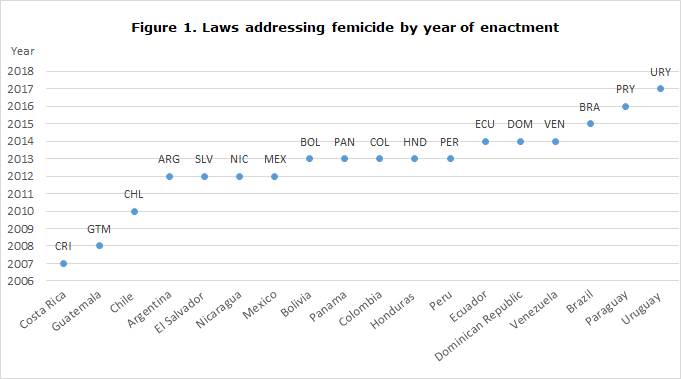Addressing femicide in the context of rampant violence against women in Latin America
March 2020 - Violence against women (VAW) in Latin America and the Caribbean (LAC) constitutes a pervasive issue, which culminates into high rates of femicides – or feminicides.[1] The Social Institutions and Gender Index (SIGI) regional report on LAC reveals that 27% of women in the region had suffered violence from an intimate partner at least once in their lifetime, reaching 33% in South America. The issue stems from legal frameworks that fail to comprehensively cover all forms of violence against women. Gender norms also play an important part in the ongoing dynamic by upholding attitudes that justify domestic violence: 11% of women in the region continue to believe that a husband is justified in beating his wife under certain circumstances.[2] Moreover, as a culmination of VAW, femicide has become an endemic problem: the LAC region holds the highest rates of femicide around the world. In 2018, 3,529 women were killed across the entire region because of their gender.[3]
In the past decade, femicide has progressively gained attention from the region’s governments. Policy-makers have taken steps to strengthen the legal frameworks and to implement innovative prevention mechanisms. In order to punish this crime, 18 countries in the region have passed or amended laws to sanction this crime by classifying it as feminicide, femicide or aggravated homicide due to gender (Figure 1). In parallel, some countries such as Uruguay, Panama and some states in Mexico are experimenting innovative ways to stop femicides, using electronic surveillance devices for instance to ensure protective orders are not violated (ECLAC, 2018).
|
Note: The figure presents the year when the country first enacted a law specifically addressing femicide. Source: OECD (2019) SIGI Country Profiles (genderindex.org), and UN Women (2018) |
To contain and address the issue of femicide in the LAC region, governments and policy-makers must undertake more concrete and novel actions. To help policy-makers turn the tide on a topic that remains a fundamental human rights violation, the SIGI regional report on LAC lays out some essential policy recommendations, including:
- Update accordingly the legal frameworks in the countries that still have not classified the intentional killing of a woman based on her gender as feminicide, femicide or aggravated homicide due to gender.
- Generalise the use of electronic surveillance technologies to prevent femicides when protective orders are in place, building on the ongoing experiences in Mexico, Panama and Uruguay.
- Ensure that potential aggressors are prohibited from buying firearms as studies have found that the risk of femicide increases significantly when the aggressor has access to a firearm.
- Conduct awareness-raising campaigns about machismo and its relation with violent crime, and work with schools and youth programs to deconstruct gender identities and the way that some masculinities can promote violence.
- Invest in the systematic collection of data on violence against women, both in terms of prevalence and incidence, disaggregated by type of violence and location, as well as the collection of data on attitudes towards the social acceptation of such violence.
Further reading:
OECD (forthcoming), SIGI 2019 Regional Report for Latin America and the Caribbean.
OECD (2019), SIGI 2019 Global Report: Transforming Challenges into Opportunities.
ECLAC (2018), Femicide, the most extreme expression of violence against women, Notes for Equality No. 27.
UN Women (2018), Analysis of Femicide/Feminicide Legislation in Latin America and the Caribbean and Proposal for a Model of Law.
Browse the SIGI and the Gender, Institutions and Development Database.
[1] The intentional killing of a woman or girl because of her gender.
[2] Namely if a wife burns the food, argues with her husband, goes out without telling her husband, neglects the children, or refuses sexual relationship.
[3] Annual total number of homicides of women, aged 15 years over, killed by gender violence. Source: CEPALSTAT, https://oig.cepal.org/en/indicators/femicide-or-feminicide (accessed 11 February 2020).
Documents connexes


